
Editor's note: CGTN's First Voice provides instant commentary on breaking stories. The daily column clarifies emerging issues and better defines the news agenda, offering a Chinese perspective on the latest global events.
The devastating COVID-19 crisis continues to rage around the globe. With the prolonged lockdown and continuous disruptions to the social and economic order, impatience has grown in many countries, most notably in America where anti-lockdown protests have been held, and governors of some states have hastily opted for easing restrictions despite warnings from medical experts.
In contrast, a different scene has been unfolding in China where a sense of normalcy has gradually resumed as businesses reopen, heavy traffic returns to the streets, and people come out more often in the warming springtime.
What happens in China offers an early look for other countries into the possible ways to leave lockdown and reopen the economy safely and what the post-COVID-19 business environment can look like.
In China's case, reopening had happened with caution and only took place when the conditions became ripe. In stark contrast to the timing of the debate in America about reopening - at a time when the U.S. is still struggling with staggering increases of daily infections, China decided to end lockdown in the epicenter of its COVID-19 outbreak, Wuhan on April 8, 20 days after local transmissions in the country had almost disappeared.
And since the situation improved, China has adopted a phased approach to reopening different parts of the country and different sectors. Things are being done slowly and cautiously.
Chinese President Xi Jinping has toured and inspected government work in three cities in the country, including Wuhan, Hangzhou, and Xi'an since March 9. During his trips, the message has been clear - there is an urgent need to restart the economy that has been put in hibernation for almost two months, but the efforts to revive the economy should only be allowed to proceed with the assurance that risks for more COVID-19 infections are very low.
This message is echoed by New York Times science and health reporter Donald G. McNeil Jr., who, during an interview with America's National Public Radio (NPR), commented that the attempt to reopen some parts of America now is premature. He pointed to China, saying that the country didn't reopen until it had seen "zero new infections a day" and warned that Americans' eagerness to go out when the end of the epidemic is still a distant vision is the very reason for the over 30,000 daily infections in the country. The conclusion, therefore, is that the decision to exit lockdown should not be rushed.
Another lesson that could be drawn from China concerns what practice can be adopted by businesses to make sure there is no second wave of infections as they resume operation. According to China's Ministry of Industry and Information Technology, as of late March, 98.6 percent of China's largest companies, such as industrial enterprises, had reopened while the figure for small and medium-sized enterprises was 76 percent. How has the country made sure that it doesn't lead to renewed risks?

A staff member (R) gives a takeaway pizza to a customer in a restaurant that provides takeaway service only due to the concern of COVID-19 in Dusseldorf, Germany, April 28, 2020. /Xinhua
A staff member (R) gives a takeaway pizza to a customer in a restaurant that provides takeaway service only due to the concern of COVID-19 in Dusseldorf, Germany, April 28, 2020. /Xinhua
The Economist has recently released a video where China's practice is believed to be worth looking at, which includes "capping the number of people in restaurants and public places" and "severely limiting the number of workers that firms can have on site each day." In other words, social distancing and precautionary measures are still very much kept in place in China, and with these measures, it is pointed out that it has "avoided the second wave of infections."
CNN also put out an article this Friday where it is noted that Wall Street analysts have been looking at corporate responses in China and learning useful practices. For example, Volkswagen's experience resuming business at 32 of its 33 factories in China had proved useful when the automobile giant reopened its plant in Wolfsburg in Germany this week.
Furthermore, China's experience is worth heeding because the dynamics playing out in its current business environment could provide valuable insights into how ways of doing business could be altered in the future.
For instance, the current situation has made it clear that by moving businesses online, companies could not only survive in this harsh environment but possibly fare even better. Online shopping has traditionally assumed a strong presence in the Chinese market. The COVID-19 has further accelerated the pace for some companies to lure customers online. Nike, for instance, according to the CNN article, saw its digital sales in China rose more than 30 percent last quarter. Moreover, the weekly active users for the company's activity apps also jumped 80 percent. This shows that the evolution of China's business practice during the ongoing pandemic has shed new light on how companies could improve and innovate ways of operating in the future.
In conclusion, in the midst of the global debate about how long the lockdown measures should be kept in place and how to reopen, it is worth looking at China for inspiration. The country is trying to make sure its reopening is as safe as possible without causing new waves of infections. Companies there are also pioneering their COVID-19 exit strategy and exploring different new business opportunities and models in the post-COVID-19 world.
Scriptwriter: Xu Sicong
(If you want to contribute and have specific expertise, please contact us at opinions@cgtn.com.)